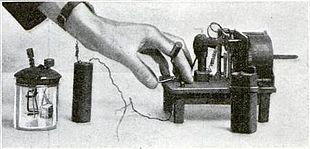I always thought that either Heinrich Hertz, Marconi or Faraday realized the first radio transmission. But someone was ahead of them;
David Edward Hughes (16 May 1831 – 22 January 1900), was a British-American inventor, practical experimenter, and professor of music known for his work on the printing telegraph and the microphone. His family moved to the U.S. while he was a child and he became a professor of music in Kentucky. In 1855 he patented a printing telegraph. He moved back to London in 1857 and further pursued experimentation and invention, coming up with an improved carbon microphone in 1878. In 1879 he identified what seemed to be a new phenomenon during his experiments: sparking in one device could be heard in a separate portable microphone apparatus he had set up. It was most probably radio transmissions but this was nine years before electromagnetic radiation was a proven concept and Hughes was convinced by others that his discovery was simply electromagnetic induction.

Hughes seems to have come across the phenomenon of radio waves nine years before they were proven to exist by Heinrich Hertz in 1888. In 1879 while working in London, Hughes discovered that a bad contact in a Bell telephone he was using in his experiments seemed to be sparking when he worked on a nearby induction balance. He developed an improved detector to pick up this unknown 'extra current' based on his new microphone design and developed a way to interrupt his induction balance via a clockwork mechanism to produce a series of sparks. By trial and error experiments he eventually found he could pick up these 'aerial waves' as he carried his telephone device down the street out to a range of almost 500 meters.
Hughes wireless apparatus, a clockwork driven spark transmitter and battery (right) and a modified version of his carbon block microphone (left) which he used in his 1879 experiments.








